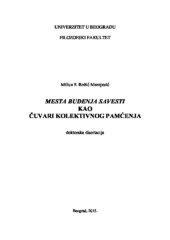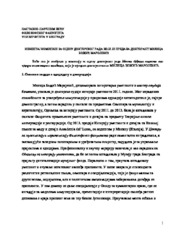Приказ основних података о дисертацији
Mesta buđenja savesti kao čuvari kolektivnog pamćenja
Sites of conscience as guardians of the collective memory
| dc.contributor.advisor | Bulatović, Dragan | |
| dc.contributor.other | Ristović, Milan | |
| dc.contributor.other | Radić, Nenad | |
| dc.contributor.other | Popadić, Milan | |
| dc.creator | Božić Marojević, Milica S. | |
| dc.date.accessioned | 2016-03-20T16:59:03Z | |
| dc.date.available | 2016-03-20T16:59:03Z | |
| dc.date.available | 2020-07-03T10:02:08Z | |
| dc.date.issued | 2015-11-24 | |
| dc.identifier.uri | https://nardus.mpn.gov.rs/handle/123456789/4957 | |
| dc.identifier.uri | http://eteze.bg.ac.rs/application/showtheses?thesesId=2611 | |
| dc.identifier.uri | https://fedorabg.bg.ac.rs/fedora/get/o:10694/bdef:Content/download | |
| dc.identifier.uri | http://vbs.rs/scripts/cobiss?command=DISPLAY&base=70036&RID=47640335 | |
| dc.description.abstract | Kada je kraj XX veka doneo etniĉki motivisane sukobe u Evropi, ali i neprijateljstva unutar granica represivnih reţima u drugim delovima sveta, bilo je jasno da nijedan postojeći naĉin pamćenja i didaktiĉkog delovanja u pravcu neponavljanja zloĉina nije ostvario rezultat. Na krilaticu never again senku je bacilo novo, neţeljeno nasleĎe te se opravdano postavilo pitanje - ako to nasleĊe treba ĉuvati, koji bi bio najzahvalniji model za to? Kroz promišljanja o povezivanju sećanja, inaĉe elementa neopipljive baštine, sa fiziĉkim prostorom, te istraţivanja kako taj odnos interpretirati kao muzeološku / heritološku temu iskristalisao se i odgovor na gore postavljenu nedoumicu. Rešenje se pronašlo u mestima buĎenja savesti, jedinstvenim modelima oĉuvanja kolektivne memorije i disonantnog nasleĊa u tranzicionim društvima koja su u bliskoj prošlosti pretrpela masovne zloĉine. Reĉ je o fenomenima koji obuhvataju elemente mnogih ranijih vidova memorijalizacije, a svoju misiju postiţu ispitivanjem odnosa izmeĊu kulturnog identiteta, svakodnevnog ţivota, politike, pamćenja i prostora. Uz nezaobilaznu emotivnu i pedagošku funkciju, mesta buĎenja savesti treba da budu svedoci kako su se pojedinci odnosili prema sukobima u prošlosti, meĊusobna veza sa ljudima u nekim drugaĉijim okolnostima, ali i prostor od poverenja za savladavanje novih stanovišta. Najveći izazov u postizanju tih ciljeva svakako je prilagoĊavanje komemorativne umetnosti potrebama lokalnog stanovništva, specifiĉnom kontekstu i kulturi. Iz perspektive tranzicione pravde, gde se ovaj termin prvi put pominje, mesta buĎenja savesti su deo procesa memorijalizacije u domenu simboliĉkih reparacija. Memorijalizacija je proces kreiranja javnih memorijala, a javni memorijali obuhvataju razliĉite projekte i aktivnosti koji se dešavaju u javnoj sferi, u ţelji da zaštite sećanje na dogaĊaje, periode i liĉnosti od znaĉaja za ţivot odreĊene individue, porodice, društvene grupe ili zajednicu u celini... | sr |
| dc.description.abstract | When the end of the 20th century brought ethnically motivated conflicts in Europe, as well as hostilities within the borders of repressive regimes in other parts of the world, it was clear that no existing form of remembrance and didactics aimed at preventing the recurrence of crimes had succeeded. A new, dissonant heritage cast a shadow over the slogan never again, and thus a valid question has been raised - if this legacy is to be protected, what would be the most appropriate model for that? The answer to the aforementioned dilemma has taken shape through reflection on ways to connect memory, as an element of intangible heritage, to physical space, and through research on ways to interpret this relationship as a subject of museology/ heritology. The solution has been found in sites of conscience, a unique model of preserving the collective memory and dissonant heritage in the societies in transition that have suffered mass atrocities in the recent past. We refer to the phenomena that include elements of many earlier forms of memorialization, fulfilling their mission by examining the links between cultural identity, daily life, politics, memory and space. With the inevitable emotional and pedagogical functions, sites of conscience should present how individuals related to the past conflicts, they should connect people who now find themselves in different circumstances, but also be areas of confidence building to gain new perspectives. The biggest challenge in achieving these goals is certainly the adjustment of commemorative art to the needs of the local population, the specific context and culture... | en |
| dc.format | application/pdf | |
| dc.language | sr | |
| dc.publisher | Универзитет у Београду, Филозофски факултет | sr |
| dc.rights | openAccess | en |
| dc.rights.uri | https://creativecommons.org/licenses/by-nc-nd/4.0/ | |
| dc.source | Универзитет у Београду | sr |
| dc.subject | mesta buĎenja savesti | sr |
| dc.subject | sites of conscience | en |
| dc.subject | disonantno nasleĊe | sr |
| dc.subject | pamćenje | sr |
| dc.subject | interpretacija | sr |
| dc.subject | upravljanje baštinom | sr |
| dc.subject | Brĉko Distrikt Bosne i Hercegovine | sr |
| dc.subject | dissonant heritage | en |
| dc.subject | memory | en |
| dc.subject | interpretation | en |
| dc.subject | heritage management | en |
| dc.subject | Brĉko Distrikt Bosne i Hercegovine | en |
| dc.title | Mesta buđenja savesti kao čuvari kolektivnog pamćenja | sr |
| dc.title | Sites of conscience as guardians of the collective memory | en |
| dc.type | doctoralThesis | en |
| dc.rights.license | BY-NC-ND | |
| dcterms.abstract | Булатовић, Драган; Ристовић, Милан; Радић, Ненад; Попадић, Милан.; Божић Маројевић, Милица С.; Места буђења савести као чувари колективног памћења; Места буђења савести као чувари колективног памћења; | |
| dc.identifier.fulltext | http://nardus.mpn.gov.rs/bitstream/id/27168/Disertacija585.pdf | |
| dc.identifier.fulltext | https://nardus.mpn.gov.rs/bitstream/id/27168/Disertacija585.pdf | |
| dc.identifier.fulltext | https://nardus.mpn.gov.rs/bitstream/id/27169/Bozic_Marojevic__Milica_S.pdf | |
| dc.identifier.fulltext | http://nardus.mpn.gov.rs/bitstream/id/27169/Bozic_Marojevic__Milica_S.pdf | |
| dc.identifier.rcub | https://hdl.handle.net/21.15107/rcub_nardus_4957 |



